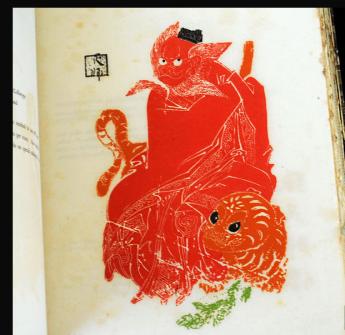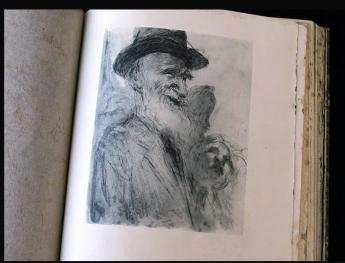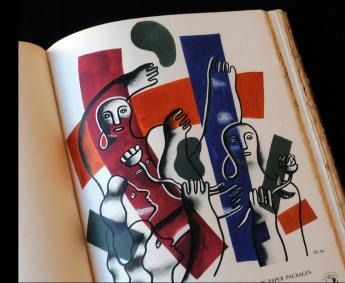Tip Antiquarian Booksellers' Association of America Lighthouse Books, ABAA
Finest Handmade Papers in the World

By Michael Slicker
In 1952, Stevens-Nelson Paper Corporation published what it called "a catalogue of the finest printing and art papers in the world." It was less boast than just a simple statement of fact. Indeed, the company had enlisted the help of small handmade paper shops across the globe.
The result was Specimens, a thick volume with deckled edges and amazing printing and artwork. Each page was a different specialty paper, varying in texture, design and thickness. The book is a remarkable find for people who love the beauty and artistry of handmade and mould-made papers and special printing techniques. A copy of Specimens is in the collection of rare and unusual book at Lighthouse Books, ABAA.
From 1901 to 1949, Stevens-Nelson, and its predecessor, Japan Paper Company, had produced broadsides (that is, large sheets) as samples to be shown to potential customers. The sheets contained work designed by some of the best typographers and printers in America. The Specimens catalogue was an effort to expand that endeavor and to provide examples of fine printing using the papers contained in the company's repetoire. The book was intended for printers and print buyers who might handle projects that called for specialty papers.
Handmade papers are created literally by hand, or using a flat, hand-manipulated mould - a wooden frame covered with wire cloth. Mould made paper is manufactured on a small, mechanically driven, cylindrical mould. In both processes, the operator hand regulates the sheet-by-sheet manufacture. It is a slow and painstaking process, as art is often likely to be.
The process is used, the book notes in the introduction, not because it is "quaint or romantic, but simply because man has not been able to devise any other means of manufacture that will produce such superlative qualities." Indeed, mass-produced papers cannot achieve the look and feel of excellence, the strength and the quality of handmade papers.
At the time the book was produced, most of the specialty papers were produced in small mills in Europe or Japan. It is noted that one mill represented in the book was founded in 1268 "and is probably the oldest in western civilization." One French mill was founded in 1492, and one of the English mills had made currency papaer for more countires than any other mill in the world.
In addition to very beautiful papers, though, the book is a repository for amazing works of art. For here is a Picasso lithograph from the Curt Valentin Gallery in New York, an illustration of George Bernard Shaw by British expressionist painter Feliks Topolski, pen and ink illustrations of Don Quixote and Sancho Panza, the cover for a menu of an elegant Paris restaurant, and so much more.
Here, too, is an illustration by Italian child prodigy Romano Dazzi, heavy covers for serious reviews and public policy forums, and a simple but elegant program cover for the installation of Dwight D. Eisenhower as president of Columbia University in 1948.
The book contains a preface by Egbert Jacobson, director of the department of design at Container Corporation of America, certainly a major user of paper. Jacobson suggests that the real importance of the book lies "in its role of pacemaker for the art of printing." He contends that printers would do well to recognize the contribution artists make to the success of the art and business of printing.
The article was posted by Michael Slicker of Lighthouse Books. It is presented here by permission of the author.


